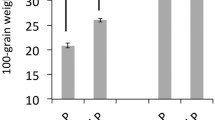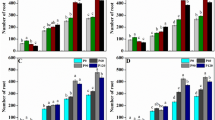Abstract
Phosphorus is an essential nutrient required for soybean growth but is bound in phytic acid which causes negative effects on both the environment as well as the animal nutrition. Lowering of phytic acid levels is associated with reduced agronomic characteristics, and relatively little information is available on the response of soybean plants to phosphorus (P) starvation. In this study, we evaluated the effects of different P starvation concentrations on the phytic acid content, growth, and yield of seven mutant genotypes along with the unirradiated control, JS-335, in a hydroponics growth system. The low phytic acid containing mutant genotypes, IR-JS-101, IR-DS-118, and IR-V-101, showed a relatively high growth rate in low P concentration containing nutrient solution (2 μM), whereas the high P concentration (50 μM) favored the growth of IR-DS-111 and IR-DS-115 mutant genotypes containing moderate phytate levels. The mutant genotypes with high phytic acid content, IR-DS-122, IR-DS-114, and JS-335, responded well under P starvation and did not have any significant effect on the growth and yield of plants. Moreover, the reduction of P concentration in nutrient solution from 50 to 2 μM also reduced the phytic acid content in the seeds of all the soybean genotypes under study. The desirable agronomic performance of low phytic acid containing mutant genotype IR-DS-118 reported in this study suggested it to be a P-efficient genotype which could be considered for agricultural practices under P limiting soils.




Similar content being viewed by others
Abbreviations
- PCA:
-
Principal component analysis
- PA:
-
Phytic acid
- SDW:
-
Seed dry weight
- SHDW:
-
Shoot dry weight
- SY:
-
Seed yield
- KOH:
-
Potassium hydroxide
References
Raboy, V., Dickinson, D. B., & Below, F. E. (1984). Variation in seed total phosphorus, phytic acid, zinc, calcium, magnesium, and protein among lines of Glycine max and G. soja. Crop Science, 24, 431–434.
Shi, J., Wang, H., Schellin, K., Li, B., Faller, M., Stoop, J. M., Meeley, R. B., Ertl, D. S., Ranch, J. P., & Glassman, K. (2007). Embryo-specific silencing of a transporter reduces phytic acid content of maize and soybean seeds. Nature Biotechnology, 25, 930–937.
Kumar, V., Rani, A., Rajpal, S., Srivastava, G., Ramesh, A., & Joshi, O. P. (2005). Phytic acid in Indian soybean: genotypic variability and influence of growing location. Journal of the Science of Food and Agriculture, 85, 1523–1526.
Corell, D. L. (1998). The role of phosphorus in the eutrophication of receiving waters: a review. Journal of Environmental Quality, 27, 261–266.
Cheryan, M., & Rackis, J. J. (1980). Phytic acid interactions in food systems. Critical Reviews in Food Science and Nutrition, 13, 297–335.
Beal, L., & Mehta, T. (1985). Zinc and phytate distribution in peas. Influence of heat treatment, germination, pH, substrate and phosphorus on pea phytate and phytase. Journal of Food Science, 50, 96–100.
Hitz, W. D., Carlson, T. J., Kerr, P. S., & Sebastian, S. A. (2002). Biochemical and molecular characterization of a mutation that confers a decreased raffinosaccharide and phytic acid phenotype on soybean seeds. Plant Physiology, 128, 650–660.
Pen, J., Verwoerd, T. C., van Paridon, P. A., Beudeker, R. F., van den Elzen, P. J. M., Geerse, K., van der Klis, J. D., Versteegh, H. A. J., van Ooyen, A. J. J., & Hoekema, A. (1993). Phytase-containing transgenic seeds as a novel feed additive for improved phosphorus utilization. Nature Biotechnology, 11, 811–814.
Meis, S. J., Fehr, W. R., & Schnebly, S. R. (2003). Seed source effect on field emergence of soybean lines with reduced phytate and raffinose saccharides. Crop Science, 43, 1336–1339.
Gaume, A., Machler, F., Leon, C. D., Narro, L., & Frossard, E. (2001). Low-P tolerance by maize (Zea mays L.) genotypes: significance of root growth, and organic acids and acid phosphatase root exudation. Plant and Soil, 228, 253–264.
Raboy, V., Hudson, S. J., & Dickson, D. B. (1985). Reduced phytic acid content does not have an adverse effect on germination of soybean seeds. Plant Physiology, 79, 323–325.
Biddinger, E. J., Liu, C., Joly, R. J., & Raghothama, K. G. (1998). Physiological and molecular responses of aeroponically grown tomato plants to phosphorus deficiency. Journal of the American Society for Horticultural Science, 123, 330–333.
Conn, S. J., Hocking, B., Dayod, M., Xu, B., Athman, A., Henderson, S., Aukett, L., Conn, V., Shearer, M. K., Fuentes, S., Tyerman, S. D., & Gilliham, M. (2013). Protocol: optimising hydroponic growth systems for nutritional and physiological analysis of Arabidopsis thaliana and other plants. Plant Methods, 9, 4.
Kumar, A., Kumar, V., Lal, S. K., Jolly, M., & Sachdev, A. (2014). Influence of gamma rays and ethyl methane sulphonate (EMS) on the levels of phytic acid, raffinose family oligosaccharides and antioxidants in soybean seeds of different genotypes. Journal of Plant Biochemistry and Biotechnology, 24, 204–209.
Raboy, V., & Dickinson, D. B. (1993). Phytic acid levels in seeds of Glycine max and G. soja as influenced by phosphorus status. Crop Science, 33, 1300–1305.
Li, H., Wang, X., Ma, Y., Wen, Z., Li, J., Zhang, H., Wu, Y., Lei, C., Wang, S., Wang, J., Geng, Z., Yang, C., Li, W., & Lu, W. (2013). Ecophysiological factors on phytic acid concentration in soybean seed. Crop Science, 53, 2195–2201.
Mollers, C., Lickfett, T., Matthaus, B. and Velasco, L. (1999) Influence of P-fertilizer on phytic acid content in seeds of Brassica napus L. and development of a NIRS calibration. In Proceedings of the 10th International Rapeseed Congress, Canberra, Australia, 26–29 September. Edited by N. Wratten and P.A. Salisbury. pp. 26–29.
Abdolzadeh, A., Wang, X., Veneklaas, E. J., & Lambers, H. (2010). Effects of phosphorus supply on growth, phosphate concentration and cluster-root formation in three Lupinus species. Annals of Botany, 105, 365–374.
Jackson, C. A., Windes, J. M., Bregitzer, P., Obert, D., Price, W., & Brown, B. (2009). Phosphorus fertility effects on the expression of the low phytic acid barley phenotype. Crop Science, 49, 1800–1806.
Asada, K., Tanaka, K., & Kasai, Z. (1969). Formation of phytic acid in cereal grains. Annals of the New York Academy of Sciences, 165, 801–814.
Michael, B., Zink, F., & Lantzch, H. J. (1980). Effect of phosphate application on phytin-phosphorous and other phosphate fractions in developing wheat grains. Journal of Plant Nutrition and Soil Science., 143, 369–376.
Raboy, V., & Dickinson, D. B. (1987). The timing and rate of phytic acid accumulation in developing soybean seeds. Plant Physiology, 85, 841–844.
Acknowledgments
The authors are grateful to the Indian Council of Agricultural Research, Ministry of Agriculture, Govt. of India for funding the National Fund Project (NASF) to carry out this research work. They are also thankful to Dr. S. K. Lal, Division of Genetics, IARI, New Delhi, for providing seeds of the different mutant genotypes.
Conflict of Interest
The authors declare that they have no competing interests.
Author information
Authors and Affiliations
Corresponding author
Rights and permissions
About this article
Cite this article
Kumar, V., Singh, T.R., Hada, A. et al. Probing Phosphorus Efficient Low Phytic Acid Content Soybean Genotypes with Phosphorus Starvation in Hydroponics Growth System. Appl Biochem Biotechnol 177, 689–699 (2015). https://doi.org/10.1007/s12010-015-1773-1
Received:
Accepted:
Published:
Issue Date:
DOI: https://doi.org/10.1007/s12010-015-1773-1




